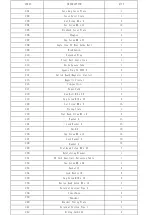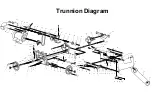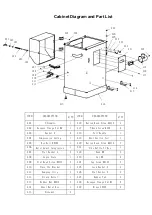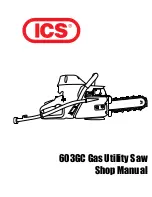
9
3.4 Installation
Before beginning assembly, take note of the
following precautions and suggestions:
FLOOR:
This tool distributes a large amount of
weight over a small area. Make certain that the
floor is capable of supporting both the weight of the
machine and the operator. The floor should also be
a level surface. If the unit wobbles or rocks once in
place, be sure to eliminate the wobble by using
shims.
WORKING CLEARANCES:
It is important to
maintain a free area of 31-1/2” (0.8 m) around the
machine, which is required for the working area. If
any long material is to be cut, it is necessary to
have sufficient room both in front of the machine as
well as behind it for material infeed and outfeed.
OUTLET PLACEMENT:
Outlets should be located
close enough to the machine so that the power
cord or extension cord is not in an area where it
would cause a tripping hazard.
DO NOT assemble the machine until you are
certain that the machine is not plugged in and
the power switch is in the OFF position.
DO NOT connect the machine to the power
source until you read and understand the entire
User Manual.
3.4.1 Remove the pallet
The machine is fixed on the pallet by M8 hex bolts.
Before installing, please take off the accessories
on the pallet and in the cabinet. Then move the
machine out after removing the set bolts under the
pallet, as shown in
Fig. 6
. Locate the machine at
appropriate place.
Fig. 6
3.4.2 Hand-wheel handle installation
Install the handle into the Blade Tilt hand-wheel as
shown in
Fig
. 7.
Fig. 7
3.4.3 Extension wings installation
(
Fig.8
)
The machine is equipped with a cast iron extension
wing on each side of the main table. The mounting
bolts of extension wings are pre-mounted in the
threaded holes on the main table sides. Install the
extension wings as follows:
1.
Remove the screws from the sides of the main
table;
2.
Inspect the extension wings and main table
mating surfaces for burrs or foreign materials that
may inhibit assembly; the mating edges of the
tables must be clean and flat, use a wire brush or
sand paper if necessary to clean up the edges;
3.
Attach the wings to the main table by using the
screws removed in step 1;
4.
Use a straightedge to check whether that the
main table is coplanar with the extension wing. If
not, use a strip of masking tape to shim the
extension wing up or down, as directed by the
arrow in Fig. 8 .
Fig. 8











































